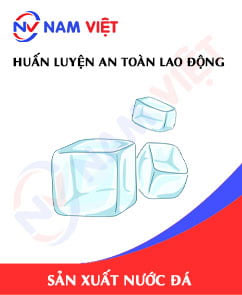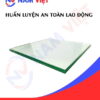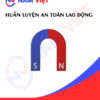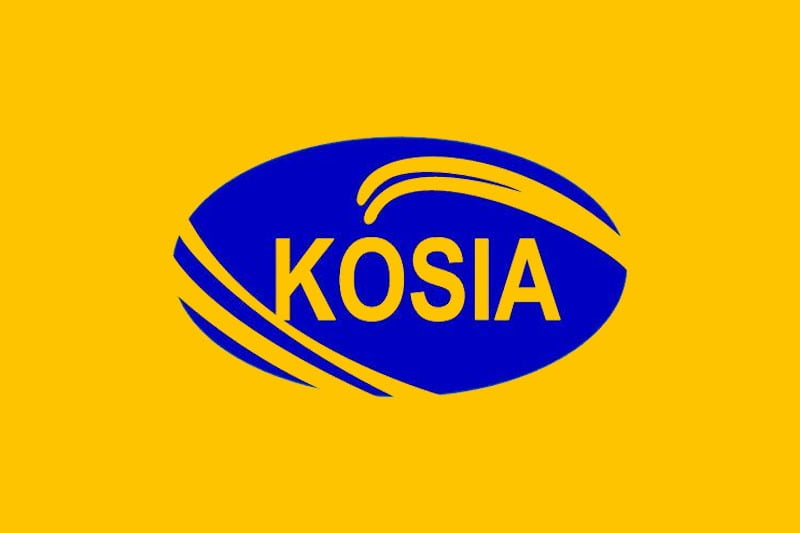Occupational Safety Training for Ice Manufacturing
99,000 ₫
Note: The above price is calculated for one person, the price may fluctuate depending on the number of trainees attending the course and market movements. For more accurate pricing support, please refer to the price list or contact our consulting staff directly.
Occupational safety is an important issue in factory manufacturing ice and needs to be addressed promptly to ensure the health and safety of workers, as well as enhance the reputation of businesses. The Occupational Safety Training course is one of the effective solutions to raise awareness of how to prevent workplace accidents for employees participating in ice manufacturing.
Table of Contents
Toggle1. Overview of Ice
a. What is ice?
- Ice is liquid water that has been frozen into a solid form through the freezing process. Ice is made by filling a container with water and placing it in a freezer until the water turns into ice.
- Ice is commonly used to cool drinks, food, or to keep beverages and food cold. It can also be used in medical applications to reduce pain or swelling.
- Ice manufacturing businesses in Vietnam vary in scale and production technology, from small producers to large industrial groups. Ice products are not only produced in traditional round shapes but also in various shapes and sizes, such as stars, squares, hearts, etc.

b. Machinery for ice production
There are various types of machinery for ice production, depending on the production scale and technology of each business. Below are some common types of ice production machines:
- Small ice pellet machines: These machines are often used by small and medium-scale ice producers. They work by pouring water into ice-shaped trays, then freezing it through circulating cold air in the machine. The ice is then ejected from the tray and collected in a storage bin.
- Flake ice machines: These machines produce flake ice, which is thin and soft, commonly used in restaurants and bars. Water is pumped onto a freezing component, then scraped into flakes and collected in a bin.
- Ice cube machines: The most popular ice production machines, widely used by large-scale ice manufacturers. Water is poured into trays, frozen through circulating cold air, then the ice trays are broken, and ice is collected in storage containers.
Additionally, there are other ice production machines such as crystal ice machines, crushed ice machines, and block ice machines, depending on the intended use and production technology of each business.

c. Ice manufacturing businesses in Vietnam
Currently, there are many ice manufacturing businesses in Vietnam with different scales and technologies. Some notable ice producers include:
- Dai Phuc Thanh Production and Trading Co., Ltd.: One of the largest ice manufacturers in Vietnam, producing ice cubes, crystal ice, and flake ice.
- Vinh Ha Mechanical and Technical Co., Ltd.: A pioneer in manufacturing ice production machinery in Vietnam, providing machines for ice cubes, flake ice, and crystal ice production.
- Viet Tan Production and Trading Co., Ltd.: Established in 2000, it is one of the leading ice producers in Vietnam, producing ice cubes, crystal ice, and flake ice.
- Dai Thanh Production and Trading Co., Ltd.: A long-established company producing ice cubes, crystal ice, and flake ice.
Other ice producers include Hoang Ha Production and Trading Co., Ltd., Minh Chau Production and Trading Co., Ltd., Van Phat Production and Trading Co., Ltd., among others. To choose a reputable and quality ice manufacturer, thorough research is required before entering into cooperation.
d. Specific jobs in an ice factory
Group 1
- CEO, Deputy CEO, and department heads in the ice production factory.
Group 2
- Safety officers: manage safety in the factory, design safety procedures, monitor and ensure employees comply with safe working procedures.
Group 3
- Water treatment: Water is the most important component in ice production. Therefore, water must be treated before use to remove impurities such as sand, mud, microorganisms, heavy metals, and chemicals, ensuring the ice is produced from clean and safe water for consumers.
- Ice material preparation: The main material for ice production is water. To produce different types of ice such as ice cubes, crystal ice, or flake ice, various processes such as molding, crystallization, and flaking are required.
- Machine operation and inspection: Ice production machinery must be operated and inspected regularly to ensure effective operation and a smooth production process without incidents.
- Packing and storage: After production, ice is properly packed and stored to maintain product quality. Packing and storage must meet food safety standards and protect ice from external factors such as light, humidity, and temperature.
- Production and quality management: Ice factories must have a production and quality management system to ensure product standards are met. Production processes must be monitored and controlled strictly from start to finish.
Group 4
- Office, service, sales, and marketing tasks.
- Human resources management, materials management, financial and accounting management.
- Research and development of new products and packaging design.

2. Overview of occupational safety training for ice production
In this article, we focus on Group 3 because they are directly involved in production and are exposed to the highest occupational safety risks. For other groups, see here.
a. What is Group 3 occupational safety training?
- Group 3 occupational safety training consists of sessions that provide awareness on preventing occupational accidents for workers.
- The training helps workers recognize hazards and prevent accidents, reducing occupational risks during work.
REGISTER FOR OCCUPATIONAL SAFETY TRAINING
b. Training duration
Initial safety training:
- Total training time is at least 24 hours, including exam time.
- 8 hours of theory on policies and laws on occupational safety and hygiene
- 8 hours of theory on basic knowledge of occupational safety and hygiene
- 4 hours of theory on specialized training content
- 2 hours of practical training on specialized content
- 2 hours of theory exam at the end of the course
The training center will divide sessions depending on employee schedules, usually 6 sessions over 3 days, provided the enterprise can arrange continuous training time.
Periodic safety training:
- Before the occupational safety card expires, employees must attend periodic occupational safety training, with duration of at least 50% of the initial training time.
Explanation: total periodic safety training time is at least 12 hours, including exam time. After completing the periodic training and passing the exam, employees will have their occupational safety cards reissued and extended.
c. Training content
| No. | TRAINING CONTENT | TRAINING DURATION (HOURS) | |||
| Total | Including | ||||
| Theory | Practice | Exam | |||
| I | Policies and laws on occupational safety and hygiene | 8 | 8 | 0 | 0 |
| 1 | Overview of legal documents system on occupational safety and hygiene. | 6 | 6 | ||
| 2 | System of safety and hygiene technical standards. | 1 | 1 | ||
| 3 | Specific regulations of state management agencies on occupational safety when constructing, expanding, or renovating production facilities, and inspecting machinery, equipment, materials, or substances with strict safety and hygiene requirements. | 1 | 1 | ||
| II | Basic knowledge on occupational safety and hygiene | 8 | 8 | 0 | 0 |
| 1 | Basic knowledge of hazardous and harmful factors at the workplace. | 4 | 4 | ||
| 2 | Methods to improve working conditions. | 1 | 1 | ||
| 3 | Safety culture in manufacturing and business. | 1 | 1 | ||
| 4 | Rights and obligations of employers and employees; occupational safety policies; functions of safety officers. | 1 | 1 | ||
| 5 | Safety rules, signs, instructions, use of safety equipment and personal protective equipment; first aid skills and occupational disease prevention. | 1 | 1 | ||
| III | Specialized training content | 6 | 4 | 2 | 0 |
| Comprehensive knowledge of machinery, equipment, substances causing hazards; risk analysis, assessment, management of occupational safety, and safe working procedures with machinery, equipment, and substances requiring strict safety and hygiene. | 6 | 4 | 2 | ||
| IV | Final exam for occupational safety training | 2 | 2 | 0 | 0 |
| Total | 24 | 22 | 2 | ||
See more training content of 6 groups
d. Occupational safety card
After completing the occupational safety training and passing the exam, employees will be issued a Group 3 occupational safety card (commonly called occupational safety certificate for Group 3).
The Group 3 safety card clearly shows: full name, date of birth, specific job and work environment, training duration, official stamp, and signature confirming course completion.
According to Clause 2 of Article 24, Decree 44/2016/ND-CP, there are two cases:
- If the employer and employee have a labor contract, the employer must sign and stamp the safety card for the Group 3 employee after training at the occupational safety training unit and passing the exam.
- If the employee is freelance or temporary, without a labor contract, the training unit must sign and stamp the safety card after training and passing the exam.

3. Identifying Hazards Affecting Workers in Ice Manufacturing
Ice manufacturing may encounter several hazards that affect workers’ health and safety. The following are common hazards in the ice manufacturing process:
- During ice manufacturing, machinery consumes a large amount of electricity. If electricity use is not controlled, electrical hazards such as short circuits, power outages, or fire may occur.
- Ice manufacturing requires food hygiene and safety. If hygiene is not properly managed and controlled, it can pose health risks to consumers, for example, ice contaminated with bacteria, viruses, or toxic chemicals.
- Many tasks in ice manufacturing require workers’ focus and caution. If safety procedures are not followed, workers may experience accidents such as scratches, cuts, or crushed hands.
- Ice manufacturing machinery generates noise during operation. Frequent exposure to high noise levels can pose auditory hazards to workers.
- Chemicals and other materials used in ice manufacturing can produce dust and toxic gases. Without proper protective equipment and adherence to health safety procedures, workers may be affected by harmful dust and chemicals.
4. Common Workplace Accidents in Ice Manufacturing
During ice manufacturing, workers may encounter various types of workplace accidents. The following are common accident types in ice manufacturing:
- Machinery accidents: During operation of ice manufacturing machinery, failure to follow proper procedures and instructions can result in cuts, crushed hands, impacts, or entrapment.
- Fire and explosion accidents: Ice manufacturing may involve flammable materials and toxic chemicals. Failure to follow safety procedures may result in fire or explosion accidents.
- Slip and fall accidents: Ice manufacturing involves frequent movement. If proper hygiene and cleaning procedures are not followed, slip and fall accidents may occur.
- Bite or burn accidents: During ice manufacturing, some equipment, materials, and chemicals can cause bites or burns to workers.
- Noise-induced accidents: Ice manufacturing machinery often produces high noise levels. Frequent exposure to high noise can cause auditory-related accidents.

5. Safety Measures for Participating in Ice Manufacturing
To ensure the safety of workers participating in ice manufacturing, the following safety measures should be implemented:
- Ensure equipment, machinery, and tools are properly maintained, regularly checked, and correctly used before operation.
- Apply safe working procedures, ensuring equipment, materials, and chemicals are used correctly and safely.
- Maintain clean and well-serviced pipes, tanks, and machinery to avoid product contamination.
- Wear full personal protective equipment, including helmets, safety shoes, goggles, masks, and gloves.
- Follow proper electrical safety procedures and prevent fire hazards during manufacturing.
- Implement safety measures during transportation, loading, unloading, and storage of ice products.
- Train staff on necessary occupational safety procedures and measures to ensure safe ice manufacturing.
- Apply accident prevention and first-aid measures when necessary.
- Monitor, evaluate, and improve ice product quality and safety to protect consumers.
- Periodically conduct workplace environmental monitoring in the factory, collecting and analyzing harmful factors for workers to reduce hazards and prevent occupational diseases.
6. Benefits of Occupational Safety Training in Ice Manufacturing
An Toan Nam Viet provides your business with the following benefits after completing occupational safety training courses according to Decree 44/2016/ND – CP on occupational safety and hygiene for companies and factories:
- Workers can recognize potential workplace hazards and take preventive measures to avoid accidents.
- Your business can establish risk prevention measures in manufacturing, operation, and maintenance processes.
- Reduce costs associated with workplace safety incidents.
- Uninterrupted production helps increase labor productivity and product quality.
- Comply with occupational safety laws, minimizing legal risks.
- Enhance professionalism and reputation, thereby improving your brand image.
An Toan Nam Viet’s training courses are a solution to prevent external factors from endangering individuals, helping them avoid injuries or even fatal accidents.
REGISTER FOR OCCUPATIONAL SAFETY TRAINING SERVICE
7. Customer Feedback After Completing Occupational Safety Training in Ice Manufacturing
An Toan Nam Viet has many years of experience supporting businesses across Vietnam, especially in the southern provinces. This responsibility is invaluable, and therefore An Toan Nam Viet’s occupational safety training has become increasingly professional.
Our growth is driven by positive feedback and suggestions from our clients. Below are some responses from partners we have served.
Hoa Dat Construction and Trading Joint Stock Company
“An Toan Nam Viet’s service has greatly helped us simplify occupational safety and complete safety documentation. The consulting team is enthusiastic and responsive to our questions. 5 stars for An Toan Nam Viet.”
See more customer interviews after using the service of An Toan Nam Viet
8. Occupational Safety Training Capacity of An Toan Nam Viet
An Toan Nam Viet is a reputable and high-quality occupational safety training center in Vietnam. Training sessions are conducted continuously at factories, manufacturing workshops, or construction sites nationwide (63 provinces in Vietnam).
REGISTER FOR OCCUPATIONAL SAFETY TRAINING SERVICE
Occupational Safety Training License
- An Toan Nam Viet has been inspected and certified by the Department of Occupational Safety under the Ministry of Labor – Invalids and Social Affairs, granting full permission for occupational safety and hygiene training. This strengthens our occupational safety training capabilities.

Training Materials and Lessons
- Before being used in occupational safety training courses, training materials are reviewed and approved to ensure accuracy and effectiveness.
- Instructors’ teaching methods follow An Toan Nam Viet standards, developed by experts in occupational safety and hygiene training to maximize knowledge absorption for trainees.
Facilities
- Controlling classroom conditions that affect training increases teaching efficiency and knowledge retention.
- Our training facilities feature spacious classrooms meeting area, lighting, and equipment standards for optimal training.
9. Nationwide Reputable Occupational Safety Training Center
At An Toan Nam Viet, we prioritize professional dedication in occupational safety training. Teaching workers self-protection skills equips them for safe work practices, contributing to national development.
To ensure training effectiveness, we meticulously prepare every detail, from tools and teaching equipment to curriculum, documents, sound, and lighting.
Our instructors are experts with many years of experience and research in identifying hazards across industries and preventing them.
Lessons are practical, vivid, and easy to understand, enabling trainees to comfortably absorb knowledge, fully aligned with Decree 44/2016/ND-CP.
Trainees learn multiple hazard prevention measures and how to protect themselves, applying them appropriately in real work.
Our training center proudly provides professional and reputable occupational safety training with the following advantages:
- Competitive training costs without compromising quality.
- Flexible training schedules matching company production.
- Quick and compliant certification procedures.
- Instructors with extensive experience.
- Classroom conditions controlled to maximize teaching efficiency and knowledge retention.
- Lessons tailored to enterprise occupational safety requirements.
- An Toan Nam Viet works diligently and professionally to provide precise and fast customer support.

10. Additional Reference Materials for Ice Manufacturing Occupational Safety Training
- Occupational Safety Training Materials for Ice Manufacturing
- Occupational Safety Training Materials Collection
- Occupational Safety Training Test Collection
- Occupational Safety Multiple-Choice Test in Ice Manufacturing
- Slides for Occupational Safety Training in Ice Manufacturing
1 review for Occupational Safety Training for Ice Manufacturing
No comments yet















namchinh.haiphong341
Dịch vụ ở đây tốt nhé!